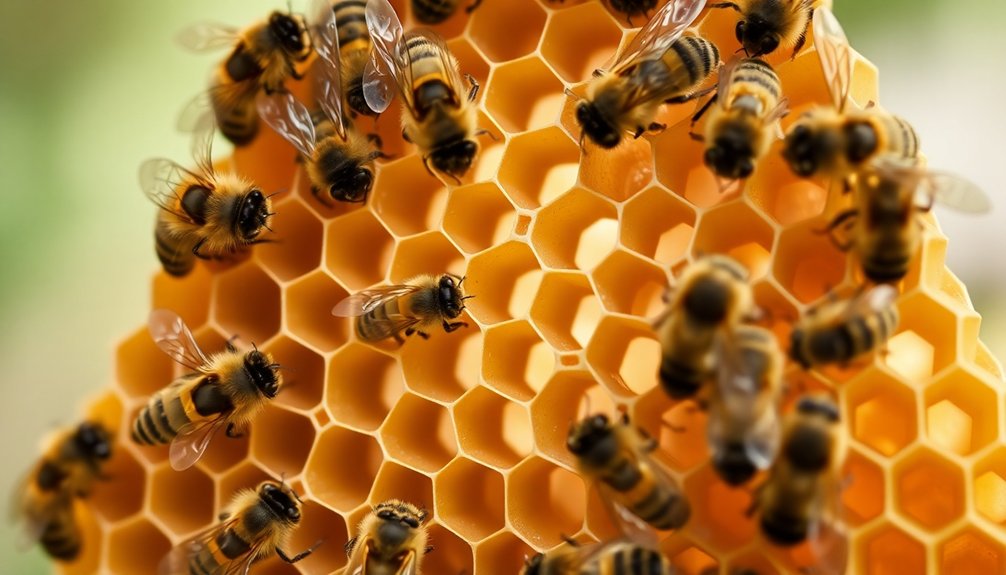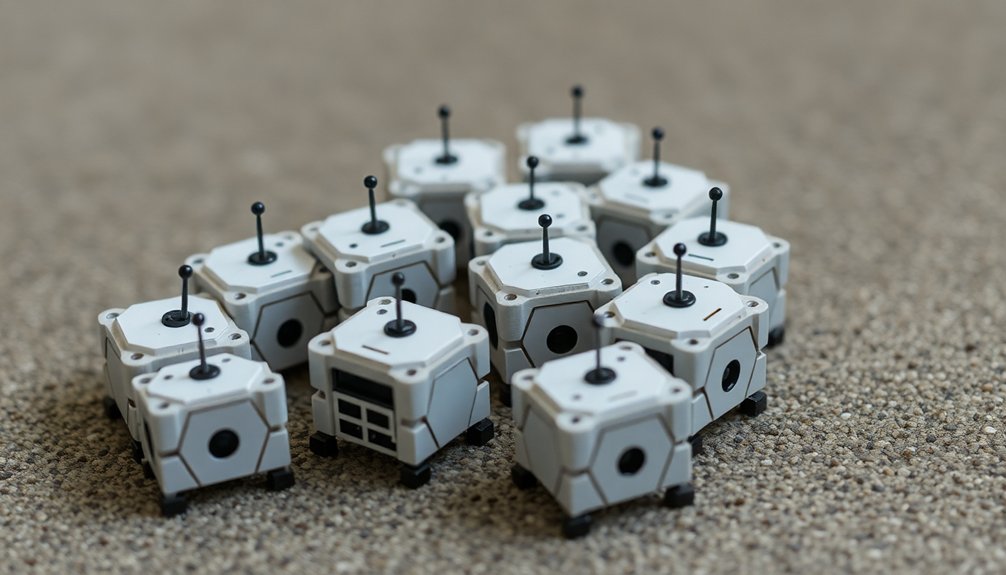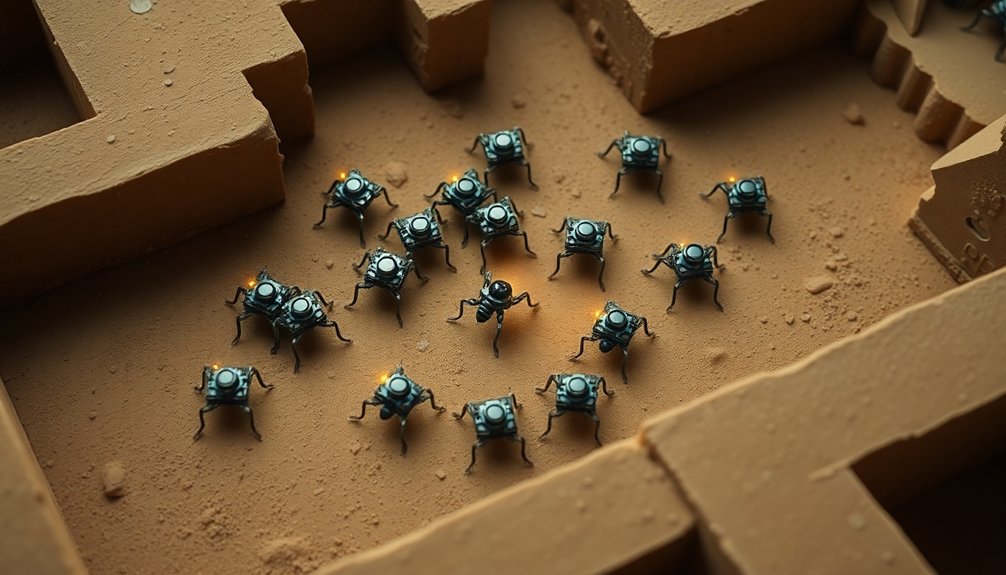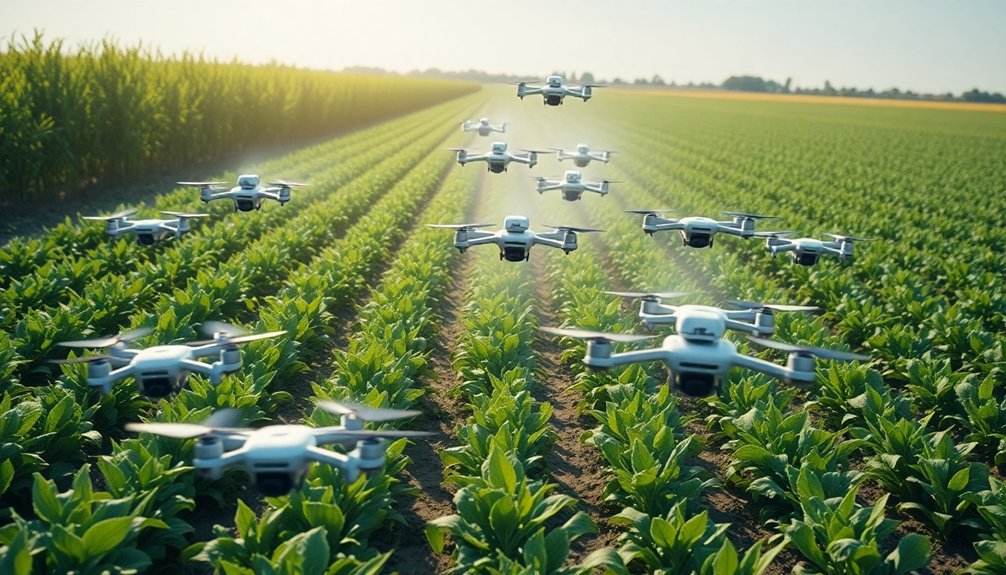Table of Contents
Imagine hundreds of tiny robots swarming like digital ants, each running simple rules but together solving impossible tasks. They communicate through invisible signals, adapting constantly without a central boss. You’ll see them mapping disaster zones, monitoring crops, or exploring dangerous spaces where humans can’t go. By mimicking nature’s most successful team players, these robot swarms turn collective intelligence from sci-fi fantasy into real-world problem-solving magic. Curious about how they do it?
The Power of Collective Intelligence

While traditional robotics often relies on centralized control and complex individual programming, swarm robotics flips the script entirely.
Imagine a robot army that thinks like a colony of ants: no boss, just pure collective intelligence. Each tiny unit follows simple rules, but together they solve mind-blowing challenges.
Tiny robots, big brains: decentralized swarms solving complex problems through elegant, collective intelligence.
Want to map an earthquake zone? Send in a swarm. Need to deliver packages across rough terrain? Deploy your robot squad.
The magic happens when these simple machines interact, creating sophisticated behaviors that no single robot could achieve alone. Decentralized control enables these robots to operate independently while achieving complex collective goals.
It’s like turning a bunch of basic LEGO pieces into an incredible, adaptive structure that thinks and moves as one.
Think less “robot overlord” and more “collaborative problem-solving machine” that can adapt, respond, and conquer tasks with shocking efficiency. Army ants demonstrate that even simple organisms can create complex structures through collective bridge-building when each unit follows basic interaction rules.
Nature’s Blueprint for Robotic Cooperation
Because nature’s been running the ultimate engineering experiment for millions of years, robot designers are now stealing her most brilliant playbook: collective intelligence.
Think about ant colonies or bee swarms—tiny creatures with zero individual smarts that somehow solve massive problems together. They don’t need a boss. They just follow simple local rules and boom: complex missions accomplished.
Want to build smarter robots? Search no further than your backyard ecosystem. Those insects are basically biological algorithms, trading information through chemical signals and touch.
Robotic swarms can mimic this: each unit runs the same basic program, communicates locally, and adapts on the fly. No central controller needed. Just pure, distributed problem-solving that’s as elegant as it’s efficient. Snail robotic locomotion demonstrates how biological mechanisms can inspire adaptive, terrain-traversing swarm technologies that reconfigure dynamically to overcome environmental challenges.
Who knew nature was the original systems engineer?
How Individual Robots Make Collective Decisions

Imagine tiny machines using super-simple rules—like following a neighbor’s lead or voting on which way to move—that somehow transform individual limitations into collective genius. Evolutionary computation methods can help robots develop increasingly sophisticated decision-making strategies that optimize both speed and accuracy in complex environments. These swarm systems leverage collective decision-making mechanisms that enable individual robots to participate in group problem-solving through emergent intelligence.
Simple Local Rules
Imagine a robot swarm where complexity emerges from ridiculously simple rules—like ants building intricate colonies without a master architect.
Each robot follows basic local instructions: maintain distance, sense nearby teammates, react to environmental signals. Sensor data processing enables these robots to continuously collect and interpret environmental information for collective decision-making. No single robot understands the big picture, yet together they solve complex problems like exploring unknown territories or coordinating rescue missions.
Think of it like a dance where nobody knows the choreography, but everyone moves perfectly in sync. By implementing straightforward behaviors like “move toward heat” or “avoid obstacles,” individual robots create sophisticated collective intelligence. Decentralized control enables these robotic systems to dynamically adapt and redistribute tasks without centralized oversight.
These simple rules—when combined across dozens or hundreds of machines—transform into powerful problem-solving networks that adapt faster than any centralized system.
Isn’t that how nature’s most successful systems work?
Emergent Group Intelligence
When swarm robotics gets really wild, it’s less about programming individual machines and more about creating conditions where collective intelligence spontaneously emerges. Autonomous micro robots, first presented at the 2014 IEEE International Conference on Mechatronics and Automation, demonstrate how complex robotic systems can emerge from simple individual interactions. Decentralized control systems enable these robots to operate without hierarchical management, allowing emergent behaviors to develop naturally. Embodied AI principles further enhance these systems by enabling robots to learn through real-world interactions and sensory feedback.
| Emergent Behavior | Robot Strategy |
|---|---|
| Self-Organization | Local Interactions |
| Adaptive Response | Decentralized Decisions |
| Complex Problem Solving | Simple Individual Rules |
Imagine tiny robots communicating through basic signals, each making independent choices that somehow transform into coordinated group action. They’re like tiny digital ants, sensing their environment and responding to local cues without any central boss telling them what to do. These machines don’t need a master plan; they create intelligence through constant interaction, feedback loops, and dynamic task redistribution. By mimicking nature’s most successful collaborative systems, swarm robots can solve complex problems faster and more flexibly than any single programmed machine. Wild, right?
Communication Strategies in Robot Swarms
You’re probably wondering how a bunch of tiny robots actually talk to each other without turning into a chaotic mess.
Local sensor networks let these mechanical critters whisper their intentions through wireless signals and environmental marker trails, creating invisible communication highways that would make ant colonies look like amateurs. By leveraging decentralized communication protocols, these robotic systems can dynamically adapt their interactions based on local environmental feedback.
Think of it like robots leaving digital breadcrumbs that help their mechanical buddies figure out complex tasks without a single bossy central controller telling them what to do. Sensor fusion techniques enable these robotic swarms to integrate multiple sensory inputs, creating a sophisticated communication network that allows them to share critical environmental data and coordinate movements with remarkable precision. Sophisticated communication radius calculations enable these robots to coordinate their movements and share critical information across their swarm network.
Local Sensor Networks
Because robot swarms operate like living, breathing networks, communication becomes their lifeblood—the invisible nervous system that transforms individual machines into a collective intelligence. Local sensor networks are the secret sauce that makes this magic happen, enabling robots to chat, coordinate, and collectively solve problems.
- Infrared communication mimics natural swarm behavior, requiring direct line of sight
- Mesh networks allow decentralized information sharing between robots
- Unique robot IDs help establish context in message exchanges
- Routing protocols intelligently distribute messages through the swarm
- Communication modules bridge individual robots with collective intelligence
Think of it like a robotic telephone game, but with precision engineering instead of playground whispers. Each robot becomes a node in a living, breathing network—sensing, processing, and responding faster than any single machine could.
They’re not just communicating; they’re creating a distributed brain that can adapt, learn, and conquer complex challenges.
Wireless Signal Protocols
If communication is the nervous system of robot swarms, wireless signal protocols are their neural networks—complex, adaptive, and sometimes surprisingly clever. Your robot army needs to chat, and they’ve got tricks up their metallic sleeves.
| Protocol | Range | Power |
|---|---|---|
| Wi-Fi | Medium-Large | High |
| Bluetooth | Small-Medium | Moderate |
| ZigBee | Scalable | Low |
| Infrared | Short | Minimal |
Think of these protocols like secret robot languages. Wi-Fi lets them blast data across the battlefield, while ZigBee whispers efficiently. Bluetooth plays middleman, balancing connectivity and energy. Infrared? That’s for robot whispers so quiet they’re almost invisible.
Want your swarm to coordinate like a hive mind? Choose wisely. Each protocol’s a different communication strategy—some loud, some stealthy, all designed to turn individual machines into a collective intelligence.
Environmental Marker Trails
Wireless signals are great, but what if robots could leave breadcrumbs—digital pheromones that guide their mechanical buddies through complex environments?
Think of it like robotic ant trails, but way cooler and more high-tech. These environmental marker trails transform how swarms communicate and navigate, turning the physical space into a living, adaptive communication network.
- Robots deposit unique signals that other machines can detect
- Markers simulate natural pheromone diffusion and degradation
- Physical tags replace traditional wireless communication
- Trails enable decentralized decision-making
- Environmental signals persist even when individual robots disconnect
Imagine a robot squad exploring a disaster zone, leaving magnetic or LED markers that guide rescue teams through treacherous terrain.
Each trail becomes a dynamic, self-updating map—no GPS required. It’s coordination through environmental modification, proving that sometimes the smartest communication doesn’t involve talking at all.
Designing Rules for Emergent Behaviors
When designing robot swarms, the magic happens in crafting simple rules that trigger mind-blowing collective behaviors. Think of it like teaching kindergarteners complex choreography—each robot follows basic instructions, but together they create something extraordinary.
Top-down approaches let you pre-program specific goals, while bottom-up methods let behaviors emerge naturally, like how ants build intricate colonies without a master blueprint. The secret sauce? Local interactions that transform individual limitations into group superpowers.
Biologically inspired models steal tricks from nature—swarming bees, schooling fish, migrating birds—proving that simple rules can generate incredible complexity. By carefully balancing movement, communication, and environmental adaptation, you’ll design swarms that can explore, solve problems, and self-organize in ways no single robot could dream of doing alone.
Solving Complex Problems Through Distributed Intelligence

Because nature’s most brilliant problem-solvers don’t work alone, swarm robotics transforms individual machine limitations into collective superpowers.
Imagine tiny robots thinking and acting like a hive mind, solving complex challenges through distributed intelligence:
Collective machines dynamically solve problems, transforming individual weaknesses into networked computational brilliance.
- Share information rapidly across network
- Adapt instantly to changing environments
- Overcome individual unit failures seamlessly
- Process parallel information at lightning speed
- Make group decisions without central control
Technological Challenges in Swarm Robotics
Turning collective intelligence into a robotic reality isn’t all sunshine and algorithmic rainbows. Building swarms that actually work is brutal.
Imagine hundreds of robots trying to communicate without turning into a digital traffic jam. Communication gets messy fast—wireless signals clash, robots lose sync, and coordination becomes a nightmare.
Resource limitations crush your dreams: tiny robots have minimal energy, storage, and brainpower. Security? Don’t get me started. One compromised robot could hijack the entire swarm’s mission.
Scaling these systems is like herding extremely technical cats. You’ll battle communication bottlenecks, unpredictable environmental challenges, and the constant threat of system failure.
Each robot needs to be smart enough to adapt but simple enough to follow group directives. It’s a delicate dance between individual intelligence and collective performance—and right now, we’re still learning the steps.
Real-World Applications Transforming Industries

You’ve probably heard robots are cool, but swarm robotics is where things get seriously wild—imagine thousands of tiny machines working together like a hyper-intelligent ant colony to revolutionize how we grow food, respond to disasters, and transform industrial production.
Agricultural precision robots can now map crop health with microscopic sensors, while disaster response swarms can search earthquake zones faster than any human team ever could.
Industrial automation isn’t just about big machines anymore; it’s about creating adaptive, self-organizing networks of robots that can think, communicate, and solve complex problems in real-time.
Agricultural Precision Robotics
As global agriculture faces unprecedented challenges, precision robotics are swooping in like high-tech heroes to revolutionize how we grow food.
These mechanical marvels aren’t just fancy gadgets—they’re solving real-world farming problems with serious smarts.
- Autonomous drones map fields and detect crop stress in real-time
- AI-powered robots perform precise planting and targeted weeding
- Advanced sensors optimize water and fertilizer usage
- Robotic systems reduce labor costs and workplace injuries
- Smart technologies support sustainable farming practices
Imagine robots that work 24/7, never get tired, and make farming more efficient than ever before.
They’re not replacing farmers; they’re empowering them with data-driven insights and superhuman precision.
Who wouldn’t want an army of intelligent machines helping grow better, cleaner, and smarter food?
The agricultural revolution isn’t coming—it’s already here, and it’s wearing a silicon badge.
LiDAR mapping technologies enable these robotic systems to create detailed 3D environmental maps, dramatically enhancing their precision and effectiveness in agricultural settings.
Disaster Response Strategies
When disaster strikes, every second counts—and traditional human-only rescue teams just can’t cut it anymore.
Imagine swarms of tiny robots swarming through collapsed buildings, scanning for survivors where humans can’t safely go. These miniature mechanical heroes use collective intelligence to map hazardous zones, detect life signs, and relay critical information back to rescue teams.
They’re not just fancy gadgets—they’re lifesavers. Equipped with sensors that can detect heat, sound, and movement, these robots navigate treacherous debris like digital bloodhounds.
They form communication networks, deliver emergency supplies, and explore toxic environments that would kill a human in minutes. One robot fails? No problem. The swarm keeps moving, adapting, searching.
It’s not science fiction—it’s the future of disaster response.
Industrial Automation Evolution
Industrial automation isn’t just getting smarter—it’s getting swarmier. Imagine robot teams that think like a hive, adapting faster than traditional machines. These AI-powered swarms are reshaping how businesses handle complex tasks, turning clunky automation into fluid, intelligent systems.
- Decentralized robot fleets optimize workflows in real-time
- AI coordinates collective intelligence across industrial environments
- Fault-tolerant designs guarantee continuous operation despite individual robot failures
- Scalable solutions allow rapid addition or removal of robotic units
- Flexible reconfiguration enables instant adaptation to changing production needs
Think of these swarms as nimble digital ecosystems—not just machines, but collaborative networks that learn, adjust, and problem-solve on the fly.
They’re not replacing humans; they’re transforming how we approach industrial challenges, making automation smarter, more responsive, and frankly, way cooler than ever before.
From Agricultural Fields to Disaster Zones

While agricultural robots have proven their worth in precision farming, these tiny technological marvels are now eyeing even more challenging terrain: disaster zones.
Imagine miniature robots swarming through earthquake rubble, mapping safe paths for rescue teams or delivering vital supplies to unreachable areas. They’ll work like a hive mind, communicating and adapting in real-time, covering ground that would be too dangerous for humans.
Tiny robotic heroes, swarming through disaster zones, transforming chaos into hope with intelligent, coordinated rescue missions.
Their small size means they can slip through tight spaces, gather essential data, and potentially save lives. Think of them as tiny, fearless scouts with superhuman sensing capabilities.
They’ll use the same coordinated intelligence that helps them plant crops to now navigate chaos—detecting survivors, evaluating structural damage, and providing instant situational awareness.
Who said robots can’t be heroes?
The Future of Collaborative Robotic Systems
Because robots are about to get seriously social, the future of collaborative robotic systems looks less like sci-fi fantasy and more like an impending reality.
Imagine swarms of tiny machines working together like a digital ant colony, solving problems humans can’t even see coming. What makes these systems so powerful?
- Decentralized intelligence that adapts faster than traditional robots
- Modular design allowing instant scaling up or down
- Collective problem-solving across complex environments
- Resilience through redundancy and shared mission goals
- Autonomous coordination without constant human intervention
Think of it like a smart, shape-shifting workforce that can transform from search-and-rescue teams to construction crews in minutes.
These aren’t just robots; they’re collaborative intelligence systems that’ll rewrite how we tackle massive, complicated challenges. The future isn’t about one smart machine—it’s about many minds moving as one.
Ethical Considerations and Potential Impacts

As swarm robotics evolve from theoretical concept to practical technology, ethical considerations become more than just academic footnotes—they’re critical guardrails for a potentially transformative innovation.
Imagine hundreds of tiny robots working together, but who’s responsible when something goes wrong? These collective systems raise tricky questions about accountability, privacy, and moral decision-making. Can a robot swarm genuinely understand ethical boundaries?
Security risks lurk everywhere, with each tiny unit potentially becoming a vulnerability. Sustainable design matters too—these micro-machines can’t just become high-tech trash after their mission.
The real challenge isn’t just programming individual robots, but creating ethical frameworks that work when machines think and act as a collective. It’s like teaching an entire classroom to behave, not just individual students.
People Also Ask About Robots
Can Individual Robots in a Swarm Actually Think for Themselves?
You can’t attribute true independent thinking to individual robots. They’re programmed with basic rules, relying on local interactions and pre-set algorithms rather than genuine cognitive processing or self-directed reasoning.
How Do Robot Swarms Avoid Bumping Into Each Other Constantly?
You’ll prevent collisions through smart sensors and decentralized algorithms. Each robot calculates its own safe path, using infrared and lidar to detect nearby units, then instantly adjusts velocity to maintain safe distances.
What Happens if Some Robots Break Down During a Mission?
Like a resilient river flowing around stones, you’ll find the swarm adapts when robots break down. It’ll isolate failed units, redistribute tasks, and continue its mission with minimal disruption, demonstrating remarkable self-healing capabilities.
Are Swarm Robots Cheaper Than Traditional Single-Purpose Robotic Systems?
You’ll find swarm robots can be cheaper than traditional systems, especially in precision agriculture and collaborative tasks. Their adaptability, reduced hardware complexity, and lower labor costs often make them more economical for complex, dynamic missions.
How Small Can Individual Robots in a Swarm Be?
Imagine ants traversing a complex terrain—tiny yet powerful. You’ll find swarm robots can be as small as 5-10 mm, with nanorobots potentially reaching micrometer scales, though their functional capabilities dramatically shrink with size.
Why This Matters in Robotics
Swarm robotics isn’t just sci-fi fantasy—it’s the future knocking at our door. Imagine thousands of tiny robots working together like a digital ant colony, solving complex problems faster than any single machine. By 2030, experts predict swarm systems could reduce operational costs by up to 40% across industries. You’re witnessing the dawn of collective intelligence, where small, simple robots create extraordinary solutions. The revolution isn’t coming—it’s already here, quietly reshaping how we solve humanity’s most challenging problems.
References
- https://en.wikipedia.org/wiki/Swarm_robotics
- https://library.fiveable.me/swarm-intelligence-and-robotics/unit-1/definition-principles-swarm-intelligence/study-guide/QmkQBeEQnvs1olWD
- https://library.fiveable.me/evolutionary-robotics/unit-14/principles-swarm-robotics/study-guide/62ncqwnuIMY2SAol
- https://milvus.io/ai-quick-reference/what-are-the-key-principles-of-swarm-intelligence
- https://www.jetir.org/papers/JETIR2407272.pdf
- https://www.ahomtech.com/blog/swarm-robotics-the-future-of-collective-intelligence-in-machines-introduction/
- https://blogs.princeton.edu/research/2015/11/24/army-ants-living-bridges-span-collective-intelligence-swarm-robotics-pnas/
- https://curam-ai.com.au/swarm-robotics-harnessing-collective-intelligence/
- https://scalastic.io/en/drone-swarms-collective-intelligence/
- https://itresearches.com/swarm-robotics-unleashing-collective-intelligence-in-teams/
